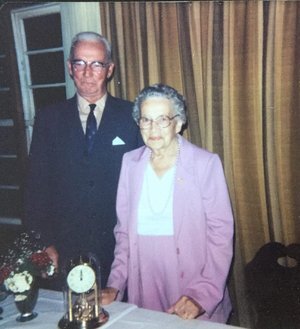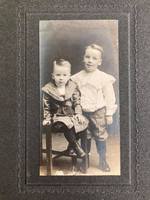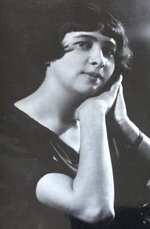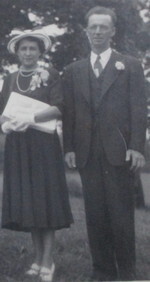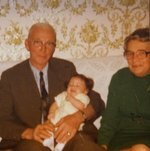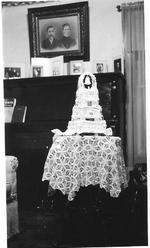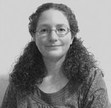Nikko Lee's Blog
December 16, 2023
Filling the Trunk
Without much fanfare, NaNoWriMo came and went for me. I wrote as much as I could and managed to get within 5k words of the 50k goal. With the words I had written since the beginning of the year, I reached 64k words with the climax and ending to write.
And it's sat as such since Nov 30.
I have a couple of trunked novel. A dark fantasy trilogy. A thriller set in a BDSM communitee. Countless started novels and short stories that have fallen by the wayside for one reason or another. I hit a deadend, got bored of the story, ran out of free time for writing, or started another project.
Initially, I have tried to think for these trunked stories as the writing dues every author owes their audience. The practice that leads to improvement. Then I hear the voice of my Sensei, 'Practice doesn't make perfect, perfect practice makes perfect.'
For the first time in almost a decade, I mapped out a novel with several charactesr and subplots along with the main murder mystery. The first draft is under 10K away from being finished. And I don't even want to look at it. I broke the dam and wrote. Yet I'm not sure the plot works. I am frustrated by my short comings as an author. I know that unless I write something unique, timely, or well-craft (preferrably all three) that the chances of achieving a print publishing contract is about as likely as getting struck by lightening – twice.
I like the advice 'Write when you are feeling inspired, read when you are not.'
Ursala K Le Guin's 'Steering The Craft: A Twenty-First-Century Guide to Sailing the Sea of Story' seems like a way forward to improving my writing craft. I'm looking forward to reading her thoughts on the craft and doing the exercises within.
January 13, 2023
Knowlton Landing: A History of Family and Place

November 14, 2022
John Dimond (1821-1860)
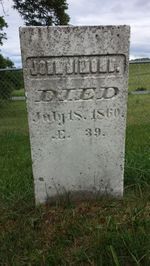 At the base of Hog’s Back Mountain, an old logging road runs the length of the mountain from Ch. Coolidge to Ch. des Falcon-Pelerines parallel to Ch. du Lac. About a third of the way south from Ch. Coolidge is a clearing where logs were piled near an old gravel pit. On the eastern side of the road there is a sunken shape of an old stone foundation and nearby a pile of rocks reminiscent of a grave. Family lore has it that the house belonged to squatters on the land during the period of time that the land was out of Knowlton hands, possibly when Charles Ethier had settled on the northern edge of lot 28 tenth range Potton township.
At the base of Hog’s Back Mountain, an old logging road runs the length of the mountain from Ch. Coolidge to Ch. des Falcon-Pelerines parallel to Ch. du Lac. About a third of the way south from Ch. Coolidge is a clearing where logs were piled near an old gravel pit. On the eastern side of the road there is a sunken shape of an old stone foundation and nearby a pile of rocks reminiscent of a grave. Family lore has it that the house belonged to squatters on the land during the period of time that the land was out of Knowlton hands, possibly when Charles Ethier had settled on the northern edge of lot 28 tenth range Potton township.
Squatters were not uncommon during the early settlement of the Eastern Townships. Nicholas Austin famously settled in Potton before being informed that his crown land grant was actually in Bolton Township further north along Lake Memphremagog. Settlers trickled into the Townships and began cultivating the land before the issues of property ownership were settled. Such was the case of Samuel Perkins who settled on lot 18 in the tenth range in the Township of Potton prior to 1842 with a ‘quit claim’ by occupier as the listed tenure. His death in 1845 established the cemetery on the lot. However, that land was a part of the crown reserve and later granted to Gardner B. Jones on May 2, 1868. Others traded land without legal documentation as was the case of the land exchanges between Richard Holland and Abraham Channell. Others simply may not have had any means to go anywhere else and may have resided in the homes or on the property of relatives, such as may have been the case for John ‘Silent’ Dimond.
In Wiilliam Bryant Bullock’s ‘Beautiful Waters: Devoted to the Memphremagog Region in History, Legend, Anecdote, Folklore, Poetry, Drama’, he describes John Dimond as
An expert fisherman of the 50's who lived in a hut was Silent Dimond and his haunt was on the west shore, opposite Georgeville. "Silent" was about as social as an Indian — monosyllables were usually the extent of a conversation. One could crack through Silent's stoicism, however, by asking if his cabin was comfortable in the zero winter nights; his expressive answer would be: "Keep h of a fire — roast on one side, freeze on t'other, bigosh!” Mr. Dimond seemed to have an uncanny instinct in locating the longe and catching them when it was impossible for others to do so.
Knowlton is located across the lake from Georgeville and may have been where John Dimond’s hut was located. The passage then goes on to describe John Dimond’s death in the waters of Lake Memphremagog; the swells became so rough they threatened to capsize the row boats of both John and fellow fisherman Moses Achilles, who had both been anchored off Black Point, one mile south of Lord’s Island. While Moses Achilles managed to make it to shore, he turned to see John Dimond’s boat empty. John was buried at the Knowlton Landing cemetery being the nephew of Levi Knowlton. The notification of death posted in the Stanstead Journal states that “John Dimond, a noted fisherman on Lake Memphremagog, recently came to his death by drowning, while in a state of temporary insanity, by jumping into the Lake from his canoe. He is said to have been a very singular person, although liked by those who were acquainted with him, and had penetrated beneath his outside coat of eccentricities.”
Another accounting of the event many years later adds more details:
‘Silent’ lived in a cabin on the western shore opposite Georgeville and came by his name by hardly saying a word to a living soul from one end of the year to another. If you said ‘Good morning,’ he couldn’t think of an answer. If you said, ‘Have a drink on me,’ he’d only grunt and nod.
He was fishing for lake trout along with Moses Achilles one day when the weather turned quickly nasty as if often does in summer. The swells got up and their anchors dragged and Moses packed up and headed his skiff for shelter. The wind howled and the lightning flashed and the rain came pelting down and Moses had a hard time making it safe but he’d looked back and had seen ‘Silent’ John rowing like mad behind him in a lightning flash. He paid little attention after that for he had all he could do to keep his own boat from swamping and, if anyone knew the weathers, it was ‘Silent’ John Dimond.
But when Moses reached shore and had time to breathe, he looked out and saw only ‘Silent’s empty skiff bobbing in the chop. They grappled for several days before they came up with the body. He was buried in Potton.
John Fitz Tuck, owner of the inn at the Landing, recounted an occurrence when he and John Dimond rescued a man who had fallen through the ice:
As I looked out on the lake one cold morning I saw a man coming on the ice where it had been open the night before. I turned my head to speak to my neighbor, Mr. Diamond, telling him a man was trying to cross the ice, then turned again to look, but by this time he had broken through. This was about one ice from the shore.
We got our boats and hand-sled as quickly as possible and went to his aid; Mr. Diamond was a first class boatman. He got into the bow and I used the oars; he made a grab for the man and caught him, then we got him into the boat. We had to break the ice a number of times before we got a hold for the boat, which we put on the sled and came to shore with the man who was nearly gone.”
John F. Tuck who later be among the men to search and retrieve John Dimond’s body from the lake following his drowning:
On hearing that Mr. John Dimond had fallen from his canoe into the lake and had been drowned near Black Point, Mr. Guilford Magoon, and I went down with others to grapple for the body. On the second day when all had given up the work, Mr. Guildford said to me: “John, let us take one more round.’ We started from the anchor where he had been fishing, following the course we thought he might take in going to the shore. We had gone some distance when Mr. Guilford called: “John, go easy; I’ve caught hold of something.” It was the body of the unfortunate man, John Dimond who was buried at Knowlton Landing in Potton.”
John ‘Silent’ Diamond was the son of John Dimond (1783-1831) and Susan Stone (1787-1877), the sister of Levi Knowlton’s second wife Philena Stone. John Dimond Sr. had come to the Eastern Townships with his father Reuben Dimond, one of Asa Porter’s original associates.
Originally settling in Brome at Dunkin Place once owned by Ezekiel Knowlton, John Dimond Sr bought lot 28 in the tenth range Bolton Township (also known as Channel Place) July 4, 1818, from Abraham Channel. On a subsequent deed in 1821 for property in Brome, John Dimond of Bolton is noted as an inn holder. However, John Dimond’s stay in Bolton was short. By 1825, he sold Channel Place (then called Dimond Place) back to Abraham Channel and purchased land in Stanstead township. Abraham Channel then sold the lake side property to Levi Knowlton, John’s brother-in-law, three months later and it was subsequently sold to Elliot Coolidge (noted as farmer of Bolton) in 1826.
John Dimond Sr. drowned in Lake Memphremagog during a winter crossing in 1831. He left behind a wife and ten children. One of their young children, Eliza Dimond, was adopted by Polly Knowlton and Elliot Coolidge where she learned all the skills to run a household and taught at the Tibbitt’s Hill school prior to marriage.37 At least one daughter, Caroline, moved to Stanbridge with Susan. Six years after the death of her husband, Susan Stone remarried to Nathan Palmer of Stanbridge, a widower with several small children of his own. Susan Stone and Nathan Palmer would die months apart in 1860. In 1848, Eliza married Orrin Rexford and their son Dr. Elson Irving Rexford, became an educator of note serving as president of the Provincial Association of Protestant Teachers. She spent most of her life caring for one sick relative or another, including her adoptive mother Polly Knowlton and brother George Dimond. In the last decade of her life, she was being freed from such burdens. At one point the six Dimond sisters (Lucinda, Philena, Caroline, Jane, Susan, and Eliza) gathered at Knowlton.
When John Dimond Jr. drowned in Lake Memphremagog as his father had 30 years earlier, he was survived by his sisters and brothers, most of whom had all married and moved away from Knowlton Landing to establish their own lives. His family at the landing included his brother George Dimond, who owned the property later known as Denman’s point, and his cousin Miles Knowlton who ran the Knowlton Landing farm. John Dimond Jr. was buried in the Knowlton Landing cemetery in the coffin originally built for James Baker Hoyt, an associate of Miles Knowlton in the Mountain House building who was presumed drowned but who had in fact escaped from debts by moving to Minnesota.
November 2, 2022
Samuel Burnham (1814-1850)
Among the graves in the Knowlton Landing Cemetery, two stand out as neither Knowltons or spouses of a Knowlton family member: John Dimond and Samuel Burnham. Both had close ties to the Knowlton family, perhaps explaining why they were buried in the family cemetery.
The son of Samuel Burnham Sr (1793-1825) and Lucy Smith (1793-1819), Samuel Burnham (1814-1850) moved with his family to Stanstead, Lower Canada, early in his life. Samuel (of Stanstead) and Lucy (of Brownington) married in Brownington, Vermont, February of 1815. Like many entrepreneuring men of the Townships, Samuel Sr. sought to establish trade between the Townships and the USA. However, these dealings landed him in court. In 1816, Samuel Sr was brought to Massachusetts court for importing goods into the United States without permission and payment of duties although Samuel claimed to have done so at Irasburg following entry into the USA via Lake Memphremagog. In 1820, Samuel Sr bought land in Montreal from Taboul Thayer despite his ties in Stanstead, perhaps owing to a lack of available or afforable land.
As late as 1821, Samuel Sr. petitioned the crown for a land grant in Stanstead county.
“The humble Petition of Samuel Burnham late of the Township of Stanstead and now of the City of Montreal, Blacksmith, most humbly beseech that your Excellency’s Petitioner hast resided some time in the Province, that in consequence of too many of his trade being in Stanstead, he removed to Montreal about two years since, that he is still desirous of settling in the County, with the wants of the inhabitants he is well acquainted and is capable of furnishing ever kind of implement necessary for a Farmer.” [dated Montreal November 1821]
Samuel was listed as an executor on Abraham Channell’s 1822 will along with Levi Knowlton. His brother-in-law, Justus Smith, operated an inn that served as the end point of the first sleigh service departing from Georgeville in 1824 that also provided mail service between Montreal and the Eastern Townships.
While his petition was recommended with him being recognized as an “ingenious, useful mechanic, and an industrious sober man’. In 1823, Samuel Smith sold 2 acres of land situated on lot four tenth range Stanstead township to his brother-in-law Ichabod Smith. By 1823, Samuel Sr was advertising his services as a blacksmith in Montreal with a shop located on St. Peter’s street. In mid-1824, Samuel Sr. transferred power of attorney to his brother-in-law Icahbod Smith. Samuel Sr’s death in early 1825 prompted the liquidation of all his assets. Residual legal action surrounding his estate continued into 1830 with another brother-in-law, Joshua Smith, as curvature of the estate being responsible for the payment of rent on property in St Anne suburb of Montreal next to Justice Smith ‘owed until 1890 and thereafter payment to the administratices of the property of the poor of Hotel Dieu [first hospital founded in Montreal].’
Between 1837 and 1846, Samuel Burnham Jr witnessed many baptisms, marriages, and deaths in Bolton and Potton Township, specifically in the Sargeant’s bay area. Although no property records or census records reveal where Samuel Jr lived, it is tempting to speculate that with his close ties to the Knowlton family that he might have resided at the Knowlton Landing farm. There exists the remains of a dug foundation and grave-like rock pile at the second landing along the road at the base of Hog’s Back mountain. There exists no recollection of who may have resided there other than they may have been squatters – common in the era of early settlement – that predates from when the Knowlton family reacquired the land.
Samuel [of Potton] married Marguerite Davis (1819-?) in 1839 and they had three children; Betsey Melvina (1839-1908), Valeria (1841-1915), and Coolidge Elliot (1845-1891). Whether due to death or circumstance, Betsey was adopted by Polly Knowlton and Elliot Coolidge, for whom Coolidge Elliot Burnham was named. Polly Knowlton set aside money for both Betsey and Coolidge in her last will and testament. Betsey Burham married Charles Carroll Bullock, captain of the Steamer Lady of the Lake. They built their home in Knowlton Landing, which was later known as Greenacres and residence of the Drummond family. In the 1980’s the property was purchased and remodeled by Michel Gauthier. Valerie married James Spence and moved to Ontario. Coolidge Elliot married Mary ‘Jennie’ Fitzgerald and moved to Framingham, Mass.
When Samuel Burnham [of Potton] was baptized into the Methodist church in July of 1842 at the age of 28, Caroline Dimond, daughter of John Dimond Sr and Susan Stone, was a witness. The same year he was also sworn in as a justice of the peace. In 1849, he served as part of the committee of trustees for creditors of Miles Knowlton, who was suffering from severe conjunctivitis to the point of blindness.
Samuel Burnham died June 3, 1850, and was buried in the Knowlton Landing cemetery. His death record lists him as a ‘Farmer of the Town of Potton County of Stanstead and District of Montreal’.
February 8, 2022
Reclaiming me
'Me' is continuously changing. Sometimes the changes are incremental and only noticeable in the long run. Sometimes the changes are dramatic and earth shattering. I'm not the same person I was ten years ago. Nor am I the person I will be ten years from now.
I wanted a way to capture me. Who I am now, in this moments. All of what I consider to be me.
To my children I am mom. That me is not the same me that I am to my friends or coworkers. Those me's aren't even the same me I am to myself and in my mind.
I have been a lot of things. Student. Teacher. Author. Artist. Quiet. Loud. Outgoing. Introverted. Worker. Mother. Hiker. Dog owner.
The people who have known me the longest have probably seen the many me's that I have been and yet some parts of me have only been shown to a select few people.
After seven years of motherhood that striped me down to what I could do to keep two tiny, precious souls alive without losing every aspect of myself, I am starting to feel like I have more space and energy to give back to myself and my own interest. Now I am trying to figure out what I mean to myself, the things that are important to me, and who I aspire to be.
Creativity is very important to me.
Nature is essential to my happiness.
I require solitude as well as friends to share conversation and food with.
My children are my heart and soul.
There is energy within me that I need to share through painting, writing, and just being in the same space as the people who enjoy similar things as I do.
I abhor conflict but love a good argument.
There is still so much I want to learn about people, nature, the world, and the unseen.
So how to capture the me of this moment?
I sought out the help of a very talented photographer, Amanda Clark. I've never done boudoir photos before and started with the basic concept of a 1950s pinup look. Then I added a steampunk outfit. After two reschedulings because of kid-related issues, I decided to splurge on a more expensive photo shoot package and added a third nature-theme.
One snowy day in January after getting the kids to school, I arrived at Amanda's studio with an armful of outfits and accessories. I'm not one for wearing much make-up. I find it irritates my skin. I can't stand having it wipe off. So I've never really learned more than a few basic techniques. I was game for whatever Amanda thought would work best with my outfits.
I was really impressed with the care and time she took picking out the right make-up and going through the glamming up process. I never knew how much was involved in making those picture-perfect looks. She even managed to find a look to tame my curly hair without restraining it.
There is something quite wonderful about having someone completely focused on helping you look your best and encouraging you to express yourself without judgement or fear. I felt completely at ease with Amanda. It was an experience getting my body into the positions to accentuate and create scenes.
By the end of the shoot, I was tired. The kind of tired that comes from working hard for something that matters to me. I felt beautiful, sexy, powerful. I carried that feeling with me for the rest of the day.
So here are a few photos. Definitely an experience I'd recommend saving the money for to do at least once in your life. If I can, I'd like to do it again next year to capture the me that I will be at that moment.
January 11, 2022
Woman + baby = ?
As I try to squeeze in work hours while my kids watch way too much YouTube and I read another mother spek of being burnt out, I can't help but wonder 'If motherhood was an equation, what would the product be?'
I didn't get married until my late 30s. At the time, I had the thought that I might regret not having kids. And it was kids because having a brother and sister, I wanted my child to have one sibling to share their early life with. Like so many parents to be, I had no idea what I was getting into. Pregnancy was only the beginning of my transformation into 'mom'.
The changes where physical and hormonal at first as my body regained weight that I had struggled to loose all my adult life. The second pregnancy meant even more weight. While a good deal of it was baby-associated, a lot of it was not and even 7 years later it still haunts me.
Next came a crash course in putting someone else's existance ahead of my own. I was the provider of food, comfort, warmth, and clean diapers. I could not go anywhere without at the very least thinking about the next nursing or pumping schedule. At most, I lugged laptop, pump, daycare bags, cooler of milk along with me every morning on the way to work.
Gradually, I gained more freedom. Gradually I returned to getting 6-7 hrs of sleep a night instead of my needed 8 (but much more than the fragmented 4 hrs a night during the newborn phase).
The pandemic brought another reality crashing uping my burgeoning freedom. Mom already meant selecting a job with maximum work flexibility (even passing on a job offer for a teaching position I worked 2 years to get). Pandemic Mom meant with so much as a phone call any symblance of childcare would be pulled out from underneath my work day and I would be home with kids. Over the last 2 years, that has meant running an impromptu preK with a 3 year old throwing the lesson into chaos. Now it means running a concurrent first grade and preK class for 30-90 minutes a day while I work. It has also made me an expert in calculating how much sick time I can use up before it becomes unsustainable to work a 40 hrs a week job.
Giving up a full-time job has a number of ramafications that haunt my thoughts when I get up in the middle of the night to get a kid back to sleep or change wet bed sheets. For starters, it means less income now. Many families like my own would have to undergo a major lifestyle change to drop from two incomes to one. It means less for my retirement. That's all beside the fact that I like my job and spent a good deal of my life acquiring the credentials to work it.
So add to the counting grams of sugar in the kids snacks and hours of TV time spent the stress the ever present "mom can you..." while I wonder how sustainable this new level of 'having it all' really is.
November 14, 2021
[DRAFT] Lyman Porter Knowlton and Elsie Maud Davidson
Lyman Porter ‘Buster’ Knowlton and Elsie Maude Davidson
Among his two surviving brothers, Lyman Porter Knowlton (also known as Buster) inherited the family farm. He was born December 12, 1905, to Lyman Potter Knowlton and Hattie Cleveland. He was educated at the Coolidge school and worked on several different farms as well as his family’s. Porter was baptized into the Methodist church on March 22, 1920.
With so many brothers to share the work on the family farm, Porter managed a farm in Bolton Center (according to his nephew Clifford Young) and later worked Errol Marsh’s farm in Iron Hill. He was also a part of the Harvest train that took young men west to Saskatchewan to work the farms during the summer.
Porter married Elsie Maud Davidson (19 AUG 1903–7 NOV 1993) June 26, 1926, in Knowlton (present day Lac Brome). Elsie was one of twelve children that Alfred Davidson and Maud Proulx raised in Davidson Hill until 1916. Elsie described her home in a 1915 column in the Sherbrooke record “I live on a farm. I like it very well. We have five horses, twenty-two cows and four calves. We have seventeen sheep, also I had a pet lamb last summer.”
In 1917, Elsie lived with her grandparents, Margaret Davidson and Jeremie Proulx, in South Dunham to attend school. Elsie took a short course for an elementary school diploma at MacDonald College (Montreal) in 1921 and taught school at Davidson Hill (1921-1922), Val Perkins (1922-1926), and Coolidge school (1942-1952). Elsie and Porter’s courtship began during her tenure at the Val Perkins school.
Porter and Elsie lived at Mr. Marsh’s Iron Hill farm early in their marriage. It wasn’t until Elsie was due to give birth to their first child Ralph Frederick Sr. (born November 14, 1926) that the couple returned to Knowlton Landing. Porter continued working at the Marsh farm where the new family occupied an apartment in the main house according to Tony Marsh (Errol Marsh’s grandson). The Marsh farm was a mixed farm with brood sows, hens and cattle. After Porter’s brother Fern left to work in Montreal around 1929, Porter returned to Knowlton Landing to work on the family farm. Porter and Elsie had two daughters, June Elaine Knowlton (1928–1997), who married Howard Clay Jewett (1927–2012), and Doris Jean Knowlton (1929–2020), who married Ralph George Perkins (1924–2003).
Porter served on the Brome County Agricultural Society board as president in 1964 and was a part of various committees. At the annual Brome Fair, Porter and Elsie won numerous prizes for their maple syrup and syrup products in addition to Elsie’s flowers. Elsie was also a member of the Knowlton Landing branch of the Women’s Institute, a charitable organization that raised money for local needs, such as bursaries and Christmas gifts, as well as UNICEF.
Elsie taught for 10 years at the Coolidge school. Her recollections of her years teaching were written up in a local paper:
The school house had only one room. In the room there was a teacher’s desk, students’ desks, a cupboard for dishes, shelves for library books and a box stove. Wood for the stove was kept in an attached woodshed. Also in this woodshed there was a toilet.
The twelve to twenty children who came to school were in grades one to seven. They arrived at nine o’clock and stayed until three thirty. After hanging their coats on a nail in the classroom, they took their lunch pails to their desks.
Each child sat in an individual wooden desk which had a pullout drawer on the side to hold books. On the top of the desk there was an inkwell which was used to hold ink for fountain pens. Mrs. Knowlton taught all subjects to each grade — French, Reading, Arithmetic, History, Spelling, Scripture, Geography, Literature, Handwriting and Art. With seven grades in the same room, the teacher was busy! She taught one grade while the other students did copying from the blackboard, workbooks or studying. Students had to stay in their desks. If they needed to see the teacher at her desk, they raised one finger. If they had to go to the bathroom, they raised two fingers.
The morning began by saying the Lord’s Prayer. Next the children saluted the Union Jack, which was Canada’s flag at this time.
Mrs. Knowlton played the organ and sang hymns with the children. At recess time the children talked, played tag, baseball and hide and go seek. Sometimes the teacher stayed inside with students if they were being punished or she corrected work. Friday afternoons were special. Students got to choose what they wanted to do. Some chose coloring or reading from library books which were in the classroom.
On chilly days and in the winter time a parent started the fire before school. During the day the teacher kept the fire going. The stove was used to dry out wet clothes. It was also used to warm up hot lunches for the children. Parents took turns sending food like soup, beans and scalloped potatoes to school. The teacher warmed up the food and the children took turns washing the dishes. Mrs. Knowlton smiled when she remembered that “sometimes the boys washed dishes better than the girls.”
On the farm, Lyman Porter Knowlton oversaw 30-36 Jersey milking cows, 10-12 sows, and 25-30 finishing hogs in addition to selling wood and maple syrup. Peter Talbot recalled a memorable trip to Brome Fair riding in the back of a truck with Lyman Porter Knowlton and two grown sows. The entire hog operation was lost in a barn fire in 1976. Two years prior, Porter had deeded the farm to his son, Ralph Knowlton, Sr. However, Porter would often make trips to the sugar house well into his seventies to personally inspect each year's production by sampling a cup of hot syrup fresh off the evaporator.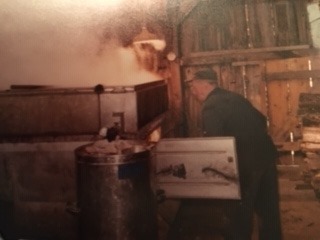
Later in life, Porter and Elsie were active members of the Golden Age Club and ardent bingo players, attending games several times a week and often returning home with door prizes for their great-grandchildren. Elsie died in 1993 and Porter in 1997. Their obituaries are a tribute to their lives and contributions to their family and communities:
“She was a quiet, gentle, kind and loving person and was known near and far for her “green thumb” in raising many African Violets for others to enjoy, as well as her love and care for her outside flower gardens. In earlier years, she enjoyed knitting, crocheting and rug making. In later years, she did crossword and jig-saw puzzles, read and exchanged books with friends and particularly enjoyed going to the local bingo games. She was a member of the former I.K. Club and the W.I. and also worked in the maple products department at Brome Fair for many years as well as being a faithful member of the local Golden Age Club.”
“Porter was well known for his love of the land, working it first with horses, which he loved to drive and take care of. Then in later years with tractors and more modern machinery. He loved children, he could be seen in younger years with scads of kids accompanying him as he delivered ice, milk and wood to the cottage people. His herd of jersey cows was his pride and joy and he delivered milk to the Magog Diary of which he was a member and shareholder for many years. Porter was President for a time, director, faithful worker of the Brome County Agricultural Fair, as well as exhibitor of maple products and winner of prizes in that department. He served on the Municipality of Potton Council for years and was always willing to lend a hand to those in need.”
I was fortunate enough to spend much of my childhood and adolescence on the farm and knew my great-grandparents. Grammy Elsie took in my plants when I had to move away. I remember chatting with her in her kitchen with the wood stove or sitting in her sunroom surrounded by plants. Grampy Porter kept a tin of Oreos on the kitchen table and would always offer the great-grandchildren one when we visited. Their house was a mystery to me with secret stairways and unused upstairs bedrooms that fascinated me. Grampy Porter would sit on his porch in the summer after he’s swept his driveway, swatting at flies and watching everyone going by. In the winter, their big dining table became a puzzle table covered in thousands of puzzle pieces.
My mother often recalled to me how Porter would help to put the syrup into containers. He was notorious for sipping off whatever syrup overflowed.
One summer, my brother and I spent two days striping and re-painting their big wrap-around porch. When the task was completed, Porter offered us $20 to split. Elsie took me aside and gave us another $20 dollars.
Just off the large porch was a huge butternut tree that reached out over the roof. Squirrels routinely stole the nuts and hid them everywhere. My great-grandfather was forever in a battle to keep them out of the attic. He would take aim at them with his rifle even with failing eyesight that left the squirrels unharmed and his car tire flat.
September 12, 2021
James Portus Cleveland
Photo taken in Idaho.
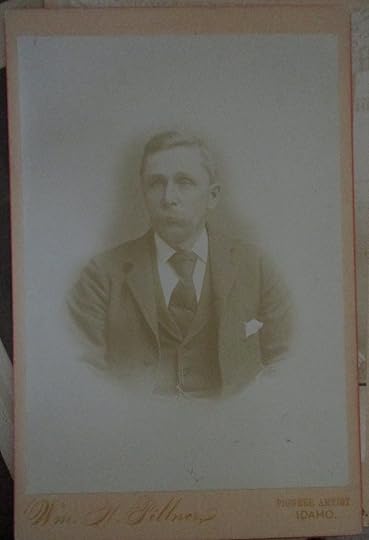
James Portus Cleveland was born April 10, 1851, in Barnston Quebec, the third of four sons (Ezra Cleveland 1841–1909, George Washinton Cleveland 1845–1847, Homer Leslie Celveland 1853–1936) of Levi Cleveland and Zilphina Baldwin. James married Mariah Agusta Oliver (1855–1895; daughter of William Luprimo Oliver and Harriet Elliott Thornton) on Feb 26, 1873 at the Barnston Methodist church.
Image from Ann Page. This photo of James and Mariah once hung over the piano at the home of Lyman Potter Knowlton and Hattie Zilpha Cleveland at Knowlton Landing.
After the birth of their first child, Harriet ‘Hattie’ Zilpha Cleveland (1877–1932), in Barnston, James and his family moved to Waterloo, Iowa, where their second daughter Ella Cleveland was born in Iowa in 1882. James had many jobs (blacksmith, surveyor, farmer, carpenter) throughout his lifetime and spent fourteen years in the western United States (Iowa and South Dakota) and Alaska before returning to Quebec in 1894 for a visit. The following year Mariah Oliver died and was buried in the Spring Hill cemetery, Gann Valley, South Dakota, the land for which was donated to the cemetery association by James and Mariah a few years earlier from the north western corner of their land grant.
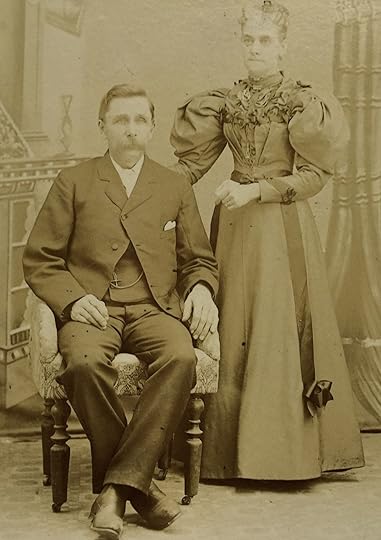
James and Susan Powles taken in Coaticook.
Shortly after the death of his wife, James remarried Susan (Powles) Dumas, widow of Jean-Baptist ‘John B’ Dumas who worked on the Cleveland family farm in Barnston before his death in St. Paul, Minnesota. James and Susan lived in Quebec for several years with daughter Ella and step-son William Dumas before moving to Shawnie, Oklahoma, where James had acquired land in the same city as his brother Ezra Cleveland. James worked as a railroad car carpenter for several years while Ezra sold real estate. Ezra and his wife Mary Slade (1844–1910) along with Susan Powles (1853–1910) share the same headstone in the Fairview Cemetery, Shawnee, Oklahoma. James returned to Barnston, Quebec, where he died October 9, 1913.
July 27, 2021
Miles Ezekiel Knowlton and Belina Ellis [draft]
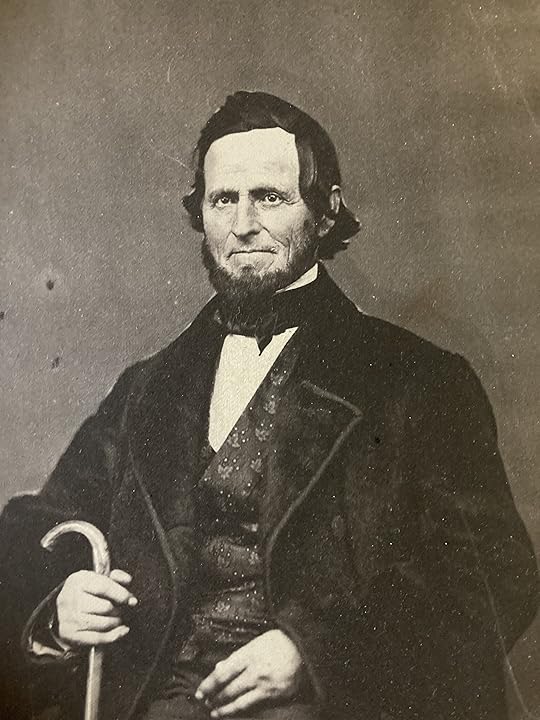
Unidentified photo presumed to be Miles Knowlton
Miles Ezekiel Knowlton was born on Dec. 8, 1809, in South Stukely, Quebec, to Levi Knowlton and Philena Stone.1 When he was twelve years old, his family moved to Knowlton Landing in Potton along the shores of Lake Memphremagog.2 From an early age, he learnt carpentry and farming skills from his father. Miles married Belina Ellis (commonly known as Belina Giddings) on March 28, 1831.3,4 They had three children: Lyman Knowlton (April 21, 1833), infant son (died shortly after birth Dec. 25, 1840), and Melinda Mariah Ellis (born April 23, 1842).5-7
Establishing Belina parentage has proved difficult. Belina's adult baptism record notes her as the daughter of Mary Ellis of Bolton.8 While no parents are listed for Belina on her marriage certificate, the two witnesses were Solomon Comstock and Jacob Giddings.9 The latter was born in Newbury, Mass., and he took his oath to the crown in 1798 along with Solomon Comstock prior to their move to Lower Canada.10 Jacob was married to Lucy Woodbury and had three children born in New Hampshire. Their last child, Stephen Giddings, was born in 1793 and moved to Lower Canada settling along the Bolton and Stukely township lines. In 1837, he purchased lot eight in the fifth range of Stukely Township from the estate of Charles Grimes as settled by the executors of his will, Jacob and George Giddings.11,12 Although no marriage record has been found as of publication, Mary Grimes (daughter of Charles Grimes and Azubah Green) is listed as the widow of the late Jacob Giddings in her burial record.13 During the settlement of the estate of Lyman Knowlton, Belina is commonly referred to as ‘commonly called Belina Giddings’.14 No information has been found regardings Belina’s birth father (surname Ellis).
Like so many men of the townships, Miles was a member of the local militia. He received his promotion from lieutenant to captain in the Stanstead Battalion May 16, 1836.15 In 1850, he resigned from his commission as captain in the militia due to a battle with ‘sore eyes’ [conjunctivitis] over a two year period that rendered him nearly blind and unable to conduct business.16
The 1842 census has slightly different lot listings for Levi and Miles, which may indicate separate residences.17 Miles had 5 people in his household (himself, wife Belina, son Lyman, a male farm hand 18-21, and an unknown 5-14 year old girl). Miles's lands produced (in Winchester bushels) 100 wheat, 40 barley, 250 oats, 15 pease, 40 Indian corn, 700 potatoes. His maple production was 300#. His livestock included 51 cows, 4 horses, 30 sheep and 4 hogs. His household produced 65 yards of non-fulled cloth and 140# of wool. Levi Knowlton died the same year of the census.
Beyond the running of the farm at Knowlton Landing, Miles Knowlton was involved in numerous land transactions and mortgages in Brome, Bolton, Potton, and Stanstead townships. Prior to his bout with conjunctivitis and establishing a creditor’s trust over his assets, Miles had legal rights over around 1000 acres in addition to the farm inherited from his father (appendix A). In a letter dated Sept 5, 1847 from Clarissa Bullock Merriman to her father, Chauncey Bullock, and step-mother, Jerusha Ives, Clarissa writes “Maria P got home from Beloit [WI] last week she brings word that they are all well doing well and contented, but Ira, and the greatest abuse of him being discontented in his dear friends in Canada are all the time teasing him to come back to Potton. They tell him that he might make a fortune at once if he would only come back and go into company with Mr. Knowlton.”18
In the space of two years, Miles had resigned his militia position and placed his land holdings in a creditors trust that included Horace Stewart trader of Stanstead, Timothy Lee Terrill of Stanstead, advocate, John Carter Tuck of Stanstead, innkeeper, Asaph Avery Knowlton of Stukely, and Samuel Burnham of Potton.19-23 The farm was placed within a creditors trust along with Miles’s other land holdings24 with the exception of 100 acres defined as:
“...commencing at the Potton line and running south to the hog pen and shed east of the red house on said lot to the Highway, west to the west corner of the shed west of the brick house hence south passing east of the burying ground twenty rods south of said burying ground hence west to the west line of the lot.”25
The bulk of Miles’s land holdings were sold to settle outstanding debts with his creditors and the trust was dissolved in September of the same year with Miles “now in a state of good health that he is able to resume management of his housings and with a portion of his debts paid.”26
In the meantime, Mile’s mother had died and he was already in the process of forging new business alliances with Captain George Fogg, an entrepreneur who was establishing the first steamboat service on Lake Memphremagog and building a lake-access only hotel, the Mountain House, at the foot of Owl’s Head Mountain.27-28 In addition to being instrumental in the rebuilding of the Mountain House following a fire, Miles was also named to the committee of Directors of the Stanstead, Shefford and Chambly Railroad, and was among the first directors of the County of Brome Agricultural Society.29,30
The investment in the Mountain House would prove troublesome between fires and disappearing partners. By 1858, Miles acquired the land the Mountain House was on from the British American Land Company and the following year sold it to Island Pond Hotel hotelier Alva Jennings.31,32 However, payment for the hotel and land was stretched out over several years.33-35 By 1860, Miles was having trouble meeting payment on his own promissory notes.36 In 1862, Miles was forced to mortgage the family farm with the exception of the 100 acres sold to his son Lyman Knowlton.37,38 Within a month of borrowing a large sum of money, the mortgage was closed on and the lands put up for sale in a sheriff's auction to Charles Channell (son of Georgeville’s iconic Abraham Fitzjohn Channell).39,40
According to the 1861 census, Miles’s family (Belina, Melinda and Osgood Brown) lived in the two-story brick house while Lyman and Sarah with Lyman Potter lived in a 1.5 story framed house.41 Although Miles’s home across the street from the red brick building was included in his forfeiture, George Giddings (Belina’s brother) bought the land and later sold it to Osgood Brown (husband of Melinda Knowlton).42,43 Miles continued to live in his home with Belina until their deaths. The red brick building was sold to John Fitz Tuck (son of John Carter Tuck and grandson of Abraham Fitzwilliam Channell) and operated as a public house and post office until the 1930s by John and later his daughter, Martha Tuck.44,45
Belina died Oct 2, 1876, of ‘congestion of the bowels’.46,47 Miles remained active cultivating his 4 acre lot growing barley, pease, potatoes, buckwheat, corn, turnips, beets, carrots (or other roots), and hay; producing maple syrup, wool, flannel, butter; and tending a milking cow, cattle, sheep, and swine.48 In August of 1882, a fire consumed the barn behind Miles’s house.49 He suffered severe burns while attempted to rescue his horse:
“Mr. Miles E. Knowlton, of Knowlton’s Landing, is now lying dangerously ill from the effects of a fire which consumed his building some days ago. It is supposed he cannot recover Sherbrooke … Fire was discovered in the barn of Miles Knowlton the 15th August. In endeavoring to save his horse, Mr. Knowlton was so severely burned, that his recovery is doubtful. His barn, horse, waggon, 1000 pounds of wool, a quantity of cloth, flour etc. were destroyed.”50
‘Uncle Miles’ as he’s called in his obituary was described as being very active ‘for one of his age’ and that he had recently bought a large number of sheep and cattle for the farm.51 The final settlement of his estate took several years and resulted in his children renouncing their inheritances and auctioning off all his possessions.52-54 Osgood Brown sold Miles’s 4 acre property including his house to John Fitz Tuck around the same time that Osgood and Melinda were finalizing their move to Lunenburg, Massachusetts.55
Sources and references:
Personal document in the collection of Rhoda (Knowlton) Potter.
Knowlton, Ralph Sr. 2001. History of Knowlton Landing. Unpublished.
Registre de Fonciere du Quebec. no 19440 Registre B38. 31 Oct. 1884. pg 267
Ancestry.com. Quebec, Canada, Vital and Church Records (Drouin Collection), 1621-1968 [database on-line]. Provo, UT, USA: Ancestry.com Operations, Inc., 2008. Original data:Gabriel Drouin, comp. Drouin Collection. Montreal, Quebec, Canada: Institut Généalogique Drouin. Anglican Church Shefford, Lower Canada. Folio fourth. 28 Mar 1831. Miles Knowlton married Belina Ellis, witnessed by Jacob Giddings and Solomon Comstock.
"Find A Grave Index," database, FamilySearch (https://www.familysearch.org/ark:/61903/1:1:QPRW-TPTM : 3 August 2020), Lyman Knowlton, ; Burial, Knowlton Landing, Estrie Region, Quebec, Canada, Knowlton Maplehurst Farm Cemetery; citing record ID 191199119, Find a Grave, http://www.findagrave.com.
"Find A Grave Index," database, FamilySearch (https://www.familysearch.org/ark:/61903/1:1:QPRW-KBCG : 2 August 2020), Infant Knowlton, ; Burial, Knowlton Landing, Estrie Region, Quebec,, Knowlton Maplehurst Farm Cemetery; citing record ID 191199110, Find a Grave
"Find A Grave Index," database, FamilySearch (https://www.familysearch.org/ark:/61903/1:1:QVKD-VHM8 : 3 August 2020), Melinda Mariah Knowlton Brown, ; Burial, Leominster, Worcester, Massachusetts, United States of America, Evergreen Cemetery; citing record ID 44546569, Find a Grave, http://www.findagrave.com.
Ancestry.com. Quebec, Canada, Vital and Church Records (Drouin Collection), 1621-1968 [database on-line]. Provo, UT, USA: Ancestry.com Operations, Inc., 2008. Original data:Gabriel Drouin, comp. Drouin Collection. Montreal, Quebec, Canada: Institut Généalogique Drouin. Bolton Methodist Church. Folio third. 19 Nov 1837.
Ancestry.com. Quebec, Canada, Vital and Church Records (Drouin Collection), 1621-1968 [database on-line]. Provo, UT, USA: Ancestry.com Operations, Inc., 2008.Original data:Gabriel Drouin, comp. Drouin Collection. Montreal, Quebec, Canada: Institut Généalogique Drouin. Anglican Church Shefford, Lower Canada. Folio fourth. 28 Mar 1831. Miles Knowlton married Belina Ellis, witnessed by Jacob Giddings and Solomon Comstock.
Notary records of Louis Chaboillez. no. 3153. 14 Sept 1798. Depot De Contrats De Concession.
Notary records of Richard Dickinson (BAnQ CN502,S20). 15 July 1837 no. 857 and 858 Sale and Conveyance of Lot eight in the fifth range Stukely Township by Stephen Giddings from the estate of Charles Grimes, executors Jacob and George Giddings.
Although documentation is lacking, George Giddings may be the son of Jacob Giddings and Mary Grimes.
Ancestry.com. Quebec, Canada, Vital and Church Records (Drouin Collection), 1621-1968 [database on-line]. Provo, UT, USA: Ancestry.com Operations, Inc., 2008.Original data:Gabriel Drouin, comp. Drouin Collection. Montreal, Quebec, Canada: Institut Généalogique Drouin. West Bolton. Folio 3. Mary Grimes, widow of the late Jacob Giddings, West Bolton, died February the third of eighteen hundred and sixty.
Registre de Fonciere du Quebec. no 19440 Registre B38 Brome. 31 Oct. 1884. pg 267.
L'Ami du peuple, de l'ordre et des lois, 15 juin 1836 Patrimoine québécois Montréal, 1832-1840 http://collections.banq.qc.ca/ark:/52327/3584226
Library and Archives Canada RG9-I-C-1. Volume/box number: 8. I-138696.
"Canada, recensement du Bas-Canada, 1842," database with images, FamilySearch (https://familysearch.org/ark:/61903/1... : 19 February 2021), Miles Knowlton, Potton, Missisquoi, Quebec, Canada; citing p. 2629, volume MG 31 C1, MG 31 C1; Library and Archives Canada microfilm number C-732, Public Archives, Ottawa, Ontario; FHL microfilm 2,443,972.
Collection of Chauncy Bullock’s personal and business documents. Ralph Knowlton Sr. 5 Sept 1847 from Clarissa Bullock Merriman to Mother [Jerusha Ives].
Horace Stewart was the owner of the Stanstead store. His grandson Horase Stewart Haskell established the building that became the Haskell Free Library and Opera House in Rock Island. https://www.waymarking.com/waymarks/WMT7ED_Ancien_magasin_Horace_Stewart_Stanstead_Qubec
Stanstead political leader. http://www.biographi.ca/en/bio/terrill_timothy_lee_10E.html
Father of John Fitz Tuck who bought the red brick public house at Knowlton Landing.
Son of Asaph Knowlton of Stukely and first cousin to Miles Knowlton.
Son of Samuel Burnham and Lucy Smith of Stanstead. He is buried in the Knowlton Landing family cemetery and his daughter was adopted by Miles's half-sister, Polly Knowlton.
Registre de Foncier du Quebec. No. 315 vol. 3 registre B Stanstead. 12 May 1849 Miles E Knowlton trader of Potton with Horace Stewart trader of Stanstead, Timothy Lee Terrill of Stanstead, advocate, John Carter Tuck of Stanstead, innkeeper, Asaph Avery Knowlton of Stukely, Samuel Burnham of Potton yeoman, acting as a committee of trustees for creditors of Miles E Knowlton. Lands within the trust include: 1) lots 27 and 28 in the 10th range Potton containing 500 acres, 2)Adams farm lot 22 and 23 in the 11th range Bolton containing 200 acres, 3) the Holland farm lot 28 in the 7th range Bolton sold to Amos Lay, William Green, and Richard Holland Jr, 4) King Farm in Bolton half of lot 27 in the 9th range Bolton save small pieces for school house and trustees of the Circuit of Methodist Society of Potton save 40 acres sold to Abraham Blake, 5) Drew farm 100 acres in south east part of said lot Bolton, 6) as on half house and store and one half piece of land said buildings are erected and being part of lot 19 in the 11th range in Bolton and being described as the same as in the deed of sale from Alexander Thompson to the said Miles Knowlton, and 7) the right of mortgage on the Tilton place or farm in Potton and all rights of mortgage on the Chapman place in Standstead.
Registre de Foncier du Quebec. No. 288 registre B3 Stanstead. 10 Jan 1849. Miles E Knowlton to Philena Stone, widow of Levi, for $1000 100 acres lot 28 10th range Potton.
Registre de Fonciere du Quebec. no. 545 Registre B3 Stanstead. Miles to the above (315) 28 Sept 1849 payment on previous loan/transfer. Miles ‘now in a state of good health that he is able to resume management of his housings And with a portion of his debts paid. Rights restored on remaining property. George Fogg and George Dimond witnesses.
"Find A Grave Index," database, FamilySearch (https://www.familysearch.org/ark:/61903/1:1:QPRW-7XT7 : 3 August 2020), Philena Stone Butterfield, ; Burial, Knowlton Landing, Estrie Region, Quebec, Canada, Knowlton Maplehurst Farm Cemetery; citing record ID 191199112, Find a Grave, http://www.findagrave.com.
Witness to the dissolution of Miles's creditors trust. Aug 8, 1855 Miles signed onto a bond for George Fogg for the Mountain Maid (149487). National Library of Canada RG4, B 28, vol. 135, Bond 2234 (file 149487).
See Mountain House chapter
MONTREAL HERALD AND DAILY'"COMMERCIAL GAZETTE, FRIDAY. JUNE 17, 1853. http://collections.banq.qc.ca/ark:/52327/3130992 Stanstead, Shefford 6l Chambly Railroad. At a meeting of the Directors of the Stanstead, Shefford and Chambly Railroad, held at Waterloo, June 10th, 1853 … And the following gentleman were named a Committee to present, and urge upon the Councils and Corporations the prayer of this Board,—and also to assist in procuring subscription of Stock: County of Stanstead.—John Gilman, Aexl. Kilborn, Horace Steward, S. Steel, S. N. Foster, Ralph Merry, Lee Knowlton, Carlton Ayer, Mo ses Copp, John W. Drew, Geo. Giddings, Jas. F. Peasley, Miles Knowlton, Horace Gran, and Or- rin Dorman, Esquires.
Taylor, E. M. (1908). History of Brome County, Quebec, from the date of grants of land therein to the present time. With records of some early families. Montreal: J. Lovell & Son. pg 170
No. deed 113 No. Sale 4400 June 30, 1858. Sold to Knowlton M.E. Eastern three-quarters lot 11 range 10 Potton 150 acres for 177. British American Land Company Fond reel C-15686, image 591 (folio 1787). Accessed with the help of Eastern Township Resource Center http://www.etrc.ca and available online at http://heritage.canadiana.ca/view/oocihm.lac_reel_c15686
Richardson, Charles Anderson. Act #6376. 17 May 1858. Miles Knowlton to Alvah Jennings of Vermont.
Richardson, Charles Anderson Act #7157 27 Sept 1860. Assignment of promissory note by Miles Knowlton to Carlos Haskell. $1255.
Richardson, Charles Anderson Act #8295 27 Oct 1863. Received $1100. Release and discharge by Carlos Haskell acting as attorney for Miles Knowlton to Alvah Jennings. For sale of Mountain House property.
Richardson, Charles Anderson #7220 27 Aug 1860. Protest at the request of the Eastern township bank to Miles Knowlton. 90 days past due on a promissory note received by A. M. Bullock for $152.
Registre de Foncier du Quebec. No. 2294 vol. 38 registre B Brome. 3 July 1862 Miles borrowed $2000 from John Tuck and Charles Channell with 300 acres of the farm as collateral.
Registre de Foncier du Quebec no. 2052 registre B Brome. Miles and Belina to Lyman registered on 3 Jan 1861 (Lefebvre notary) sum of two thousand dollars part of lot 28 and 27 10th range.
Registre de Foncier du Quebec. No. 2801 vol. 38 registre B Brome. Sheriff’s sale July 26, 1862 of 300 acres of lots 27 and 28 from Miles Knowlton to Charles Channell.
Channell, F. (2013). The Immortal Patriot. United States: Sugar Run Books.
"Canada, Québec, recensement, 1861," database, FamilySearch (https://familysearch.org/ark:/61903/1:1:MM7L-8B1 : 20 February 2021), Lyman Knolton, Patton, Brome, Quebec, Canada; citing line number 34, p. 194; Library and Archives Canada film number C-1270, Archives Publiques, Ottawa (Board of Registration and Statistics. Public Archives, Ottawa); FHL microfilm 517,363.
Registre de Foncier du Quebec. No. 3272 vol. 38 registre B Brome. 30 Aug 1864 Charles Channel sold to George Gidding the 4 acre lot of the future lot 1096 including the residence of Miles Knowlton.
Registre de Foncier du Quebec. No. 5012 vol. 38 registre B Brome. 21 July 1866 George Gidding sold to Osgood Brown the 4 acre lot of the future lot 1096 including the residence of Miles Knowlton.
Registre de Foncier du Quebec no. 4516 registre B8 On Nov 30, 1865, Charles deed to John F Tuck and Edmund J. Tuck 300 acres of lots 27 and 28 “with brickhouse, two wooden houses, barns and other cut buildings” which Channell had acquired at a sheriff’s sale July 26, 1862.
Sherbrooke Record (Sherbrooke) Bubbles By JACQUES BOISVERT of the Société d’Histoire du Lac Memphrémagog Inc. Aug 28, 1987
"Find A Grave Index," database, FamilySearch (https://www.familysearch.org/ark:/61903/1:1:QPRW-GLYZ : 3 August 2020), Belina Ellis Knowlton, ; Burial, Knowlton Landing, Estrie Region, Quebec, Canada, Knowlton Maplehurst Farm Cemetery; citing record ID 191199114, Find a Grave, http://www.findagrave.com.
Newport Express (Vermont) http://www.nekg-vt.com/news/news-newport-expressstandard-d-1872-79.php
"Canada Census, 1871," database, FamilySearch (https://www.familysearch.org/ark:/619... : 19 March 2021), Miles E. Knowlton, Potton, Brome, Quebec, Canada; citing 1871; citing National Archives of Canada, Ottawa, Ontario.
"Find A Grave Index," database, FamilySearch (https://www.familysearch.org/ark:/61903/1:1:QPRW-TPP2 : 3 August 2020), Miles Knowlton, ; Burial, Knowlton Landing, Estrie Region, Quebec, Canada, Knowlton Maplehurst Farm Cemetery; citing record ID 191199115, Find a Grave, http://www.findagrave.com.
Sherbrooke Record (Sherbrooke Quebec) 8 Aug 1882
Stanstead Journal (Stanstead Quebec) 10 Aug 1882.
Registre de Foncier du Quebec. No. 19280 vol. 38 registre B Brome. 23 July 1884 Melinda Knowlton and Osgood Brown renouncing inheritance of Miles E Knowlton.
Registre de Foncier du Quebec. No. 19440 vol. 38 registre B Brome. 28 Oct 1884 Lyman Knowlton renounces inheritance of Mile E Knowlton.
Notary records of Henri Saint-Louis. No. 2428 on 14 July 1884 Resolution of Miles Knowlton’s estate. Auction of possessions sold to John Tuck, John Bryant, and Osgood Brown. Auction raised $27.30. Estate debts totaled $166.62.
Registre de Foncier du Quebec no. 19591 Registre B vol 38 p 734. Osgood P Brown to Tuck John F 4 acres comprising the former residence of Miles Knowlton for $305.
February 19, 2021
Mountain House
 The Eastern Townships were long a buffer between nations; first the French and British and later the British and Americans. Following a rapid influx of settlers when the Eastern Townships were officially opened for settlement in 1792, the Townships rapidly grew into a region of agriculture, industry and commerce that connected Quebec to the United States. The 1850s brought an evolution in the transportation needs of those living near Lake Memphremagog1. In addition to those traveling through the area on their way to Montreal or Boston and local business needs for transporting goods from one side of the lake to the other, tourists were discovering the charms of the lake and surrounding mountains.
The Eastern Townships were long a buffer between nations; first the French and British and later the British and Americans. Following a rapid influx of settlers when the Eastern Townships were officially opened for settlement in 1792, the Townships rapidly grew into a region of agriculture, industry and commerce that connected Quebec to the United States. The 1850s brought an evolution in the transportation needs of those living near Lake Memphremagog1. In addition to those traveling through the area on their way to Montreal or Boston and local business needs for transporting goods from one side of the lake to the other, tourists were discovering the charms of the lake and surrounding mountains.
Captain George Washington Fogg, a native of Georgeville, partnered with New Hampshire entrepreneur Ephraim Cross to build the lake’s first steamboat, Jenny Lind also known as the Mountain Maid1,2. Beyond the service of transporting locals and goods, they also catered to a growing number of tourists staying at the inns along the lake by building one of the first hotels that was only accessible by boat.
The Mountain House was built on lot eleven in the tenth range of Potton at the foot of Owl’s Head mountain. The land was initially a part of the crown and clergy reserve and was eventually granted to the British American Land Company (BALC) in January 4, 18473.
Cross was no stranger to the building and running of inns as he had built the Coos Hotel in 18274. After the failure of the Lancaster Bank that Cross had helped to establish and to whose patrons he owed a considerable amount on a promissory note, Cross left New Hampshire and came to Georgeville along with his son, Col. Edward E Cross4. Their family ties in the region included Ephraim’s father, Joseph, who is buried in Pigeon Hill Cemetery, Quebec5. The original Mountain House was built in 1850 with an extension added in 18516.
When Cross returned to New Hampshire in 1854, Fogg was forced to find other partners4. Fogg and Cross sold the Mountain Maid to John Molson of Montreal and Robert Harrower of Sorel7,8, although Fogg would remain as captain of the Mountain Maid, with the exception of 1853 years, until 18689. Likewise, Fogg enlisted the help of James Baker Hoit (Hoyt), husband of Rhoda Lillie, Fogg’s sister-in-law10.
James Hoyt and his wife were the caretakers of the Mountain House when it and all their possessions were destroyed by a fire on Nov 30, 185311. The rebuilding required yet another investor. Miles Knowlton, a businessman and skilled carpenter who built the houses, inn and barns of Knowlton Landing, was involved in the rebuilding of the Mountain House, which reopened in the summer of 185412,13.
Visitors to the Mountain House enjoyed an array of activities including hiking to the summit of Owl’s Head and steamboat rides the length of the lake from Newport to Magog. Zig-zagging the lake, the steamboat made stops at a number of landings including: Magog, Bryant’s Landing, Knowlton’s Landing, Georgeville, Perkins’s Landing, Mountain House, and Newport14. The railroad brought early visitors from as far away as Richmond, Virginia15,16.
Tragedy struck again Sept 1, 1855, when James Hoit’s skiff loaded with supplies was found adrift and he was presumed to have met with foul play17. Locals recalled hearing the sounds of shots being fired that night12. The lake was dragged for three weeks, but a body was never found. It was not until the following spring when it was reported that James Hoit had in fact moved to Minnesota to escape debts much to the disapproval of locals who thought it better if “he remained forever concealed, or to have in fact found a grave at the bottom of the Lake...”18,19. He later fought in the civil war in service of the Minnesota army and wrote about his capture20. Following Hoit’s departure, Mr. Buck was caretaker of the Mountain House21.
In 1858, Miles Knowlton bought the one hundred and fifty acres of lot eleven in the tenth range on which the Mountain House was built from BALC and sold it to a Vermont hotelier Alvah Jennings, who previously operated the Island Pond Hotel, Vermont22-24. The payments stretched out over several years with the final payment arriving after Miles was forced to sell 300 acres of his farm land at Knowlton Landing in a Sheriff's auction to repay an outstanding loan25-27. The sale may not have been enough to recompense Miles’s investment. When he died in 1882 from injuries sustained in a barn fire, Miles’s estate was forced to auction off his possessions to settle his remaining debts28,29.
The following years the Mountain House changed hands multiple times with managers and owners including Mr. Emmons Raymond of Boston and Charles Watkins of New York City as the Mountain House and Lake Memphremagog remained a popular tourist destination12. The Mountain House remained in operation until October 11, 1899, when a fire that started during roof repairs destroyed the main hotel and annex30, 31.
Sources and References:
Little JI. 2018. Fashioning the Canadian Landscape: Essays on Travel Writing, Tourism, and National Identity in the Pre-Automobile Era. University of Toronto Press, Toronto, Canada.
Mills, JM. 1999. The New Mills List: Canadian Coastal and Inland Steam Vessels, 1809-1930. Marine Museum of the Great Lakes at Kingston. Accessed via http://images.maritimehistoryofthegreatlakes.ca/105418/data?n=3
Langlois C.F. 1891. List of lands granted by the crown in the province of Quebec, from 1763 to 31st December 1890. Quebec; page 239. Accessed via https://archive.org/details/cihm_94807/page/n239
Grandchamp, R. 2013. Colonel Edward E. Cross, New Hampshire Fighting Fifth: A Civil War Biography. MacFarland & Company, Inc., Publishers, North Carolina, USA.
https://www.findagrave.com/memorial/47320522/joseph-cross
Orleans County Gazette (Irasburgh, Vermont), 5 Jul 1851, Sat, page 1. Accessed via Newspaper.com.
Gibb, Isaac Jones Act #13023 June 3, 1851 Transfer by way of mortgage Robert Harrower to Ephraim Cross act #12984. Ratification by Ephraim Cross of mortgage from Robert Harrower for steam Mountain Maid see Act #12984. Accessed by request via BANQ Sherbrooke.
Gibb, Isaac Jones Act #12749, Feb. 1, 1851. Sale of the steamer Mountain Maid Geo Fogg and E Cross to John Molson. Accessed by request via Sherbrooke BAnQ.
Nelson Emily M. 1977. Frontier Crossroads:The People of Newport Vermont. Newport History Committee by Phoenix Pub, Canaan, New Hampshire.
Marriage record of James Baker Hoit to Rhoda Lillie 1850 Stanstead, Québec. Institut Généalogique Drouin; Montreal, Quebec, Canada; Drouin Collection; Author: Gabriel Drouin, comp. Year 1850, page 25. Accessed at Ancestry.com.
The Vermont Patriot and State Gazette (Montpelier, Vermont). 22 Dec 1853, Thu, page 2. Accessed at Newspaper.com.
Merrill, George C. 1917. Uriah Jewett and the Sea Serpent of Lake Memphremagog. Newport, Vermont, pages 10-12. https://archive.org/stream/uriahjewettands00currgoog/uriahjewettands00currgoog_djvu.txt
Green-Mountain Freeman (Montpelier, Vermont). 29 Jun 1854, Thu, page 3. Accessed at Newspaper.com.
Weekly Examiner (Sherbrooke, Quebec). 23 July 1886, Fri, page 3. Accessed http://collections.banq.qc.ca/ark:/52327/3468138.
Morning chronicle and commercial and shipping gazette (Quebec). lundi 6 août 1855, page 3. Accessed http://collections.banq.qc.ca/ark:/52327/3594814.
Richmond Enquirer (Richmond, Virginia). 23 Aug 1859, Thu, page 2. Accessed at Newspapers.com.
The St Johnsbury Caledonian (St. Johnsbury, Vermont). 15 Sep 1855, pg 2. Accessed at Newspapers.com.
Morning chronicle and commercial and shipping gazette. Quebec. 1 avril 1856, pg 2. Accessed http://collections.banq.qc.ca/ark:/52327/3595014
The Burlington Weekly Sentinel (Burlington, Vermont). Thursday, April 17, 1856, pg. 2. From the Stanstead Journal. Accessed at Newspapers.com.
Military order of the Loyal Legion of the U. S. Minnesota Commandery. 1909. Glimpses of the nation's struggle, Volume 6. REMINISCENCES OF MY CONFINEMENT AS A PRISONOR OF WAR. - By Lieutenant-Colonel James Baker Hoit, Third Minnesota Infantry. Accessed on Google Books.
The Gazette (Montreal, Quebec, Canada). 31 Jul 1857, Fri, Page 2. Accessed at Newspapers.com.
No. deed 113 No. Sale 4400 June 30, 1858. Sold to Knowlton M.E. Eastern three-quarters lot 11 range 10 Potton 150 acres for 177. British American Land Company Fond reel C-15686, image 591 (folio 1787). Accessed with the help of Eastern Township Resource Center http://www.etrc.ca and available online at http://heritage.canadiana.ca/view/oocihm.lac_reel_c15686
Richardson, Charles Anderson. Act #6376. 17 May 1858. Miles Knowlton to Alvah Jennings of Vermont.
Montreal herald and daily commercial gazette (Montreal, Quebec). 20 décembre 1854, page 4. Accessed http://collections.banq.qc.ca/ark:/52327/3131520
Richardson, Charles Anderson. Act #7157. 27 Sept 1860. Assignment of promissory note by Miles Knowlton to Carlos Haskell. Relating to the sale of the Mountain House property to Jennings. Accessed by request via Sherbrooke BAnQ.
Richardson, Charles Anderson. Act #8295. 27 Oct 1863. Release and discharge by Carlos Haskell acting as attorney for Miles Knowlton to Alvah Jennings. For sale of Mountain House property. Accessed by request via Sherbrooke BAnQ.
Act 2801_RB (AL_28 Brome). Sheriff’s sale 26 July 1862. Miles Knowlton to Charles Channell. Accessed via https://www.registrefoncier.gouv.qc.ca.
The Weekly Examiner (Sherbrooke, Quebec). 18 Aug 1882, page 3. http://collections.banq.qc.ca/ark:/52327/3467928
Saint-Louis, Henri. Act #2428. 14 July 1884. Resolution of Miles Knowlton’s estate. Accessed by request via Sherbrooke BAnQ.
Quebec Heritage News. Nov 2003. Vol 2 no 7, page 16. Assessed via http://qahn.org/.
Jewett, Elizabeth Liane. “Notes on Nineteenth Century Tourism on Lake Memphremagog, 1850-1899.” Journal of Eastern Townships Studies/Revue d’études des Cantons de l’Est Vol. 31 (Fall 2008): 25–43. www.etrc.ca/wp-content/uploads/2016/12/JETS_31-4-Jewett.pdf




